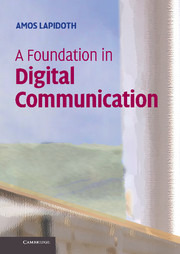Crossref Citations
This Book has been
cited by the following publications. This list is generated based on data provided by Crossref.
Koch, Tobias
and
Lapidoth, Amos
2010.
Increased capacity per unit-cost by oversampling.
p.
000684.
Aulin, Tor
2010.
Signal Processing in digital communications — The fall of science.
p.
112.
2010.
Theory and Design of Digital Communication Systems.
p.
305.
Essiambre, René-Jean
Kramer, Gerhard
Winzer, Peter J.
Foschini, Gerard J.
and
Goebel, Bernhard
2010.
Capacity Limits of Optical Fiber Networks.
Journal of Lightwave Technology,
Vol. 28,
Issue. 4,
p.
662.
2010.
Theory and Design of Digital Communication Systems.
p.
122.
2010.
Theory and Design of Digital Communication Systems.
p.
225.
Chen, Yuxin
Goldsmith, Andrea J.
and
Eldar, Yonina C.
2011.
Shannon meets Nyquist: The interplay between capacity and sampling.
p.
1090.
Bazdresch, Miguel
2011.
A real-time, Matlab-based undergraduate digital communications course.
p.
408.
Koch, Tobias
and
Lapidoth, Amos
2011.
Asymmetric quantizers are better at low SNR.
p.
2592.
Kim, Young-Han
Lapidoth, Amos
and
Weissman, Tsachy
2011.
Error Exponents for the Gaussian Channel With Active Noisy Feedback.
IEEE Transactions on Information Theory,
Vol. 57,
Issue. 3,
p.
1223.
2012.
Block Transceivers.
Hager, Christian
Amat, Alexandre Graell i
Alvarado, Alex
and
Agrell, Erik
2012.
Constellation optimization for coherent optical channels distorted by nonlinear phase noise.
p.
2870.
Alirezaei, Gholamreza
2012.
Channel capacity related power allocation for ultra-wide bandwidth sensor networks with application in object detection.
p.
115.
Alirezaei, Gholamreza
and
Mathar, Rudolf
2012.
Power allocation for power-limited sensor networks with application in object classification.
p.
1.
Durisi, Giuseppe
Morgenshtern, Veniamin I.
and
Bolcskei, Helmut
2012.
On the Sensitivity of Continuous-Time Noncoherent Fading Channel Capacity.
IEEE Transactions on Information Theory,
Vol. 58,
Issue. 10,
p.
6372.
Jalden, Joakim
and
Oechtering, Tobias J.
2013.
Distributed Bayesian detection for the butterfly network.
p.
61.
Geiger, Bernhard C.
and
Vogel, Christian
2013.
Influence of Doppler Bin Width on GPS Acquisition Probabilities.
IEEE Transactions on Aerospace and Electronic Systems,
Vol. 49,
Issue. 4,
p.
2570.
Marano, Stefano
Matta, Vincenzo
He, Ting
and
Tong, Lang
2013.
The Embedding Capacity of Information Flows Under Renewal Traffic.
IEEE Transactions on Information Theory,
Vol. 59,
Issue. 3,
p.
1724.
Alirezaei, G.
and
Mathar, R.
2013.
Channel capacity related power allocation for distributed sensor networks with application in object classification.
p.
502.
Li Bing
Baoming Bai
and
Jinfang Dou
2013.
The power spectral density of multiuser continuous phase modulation systems.
p.
1.





